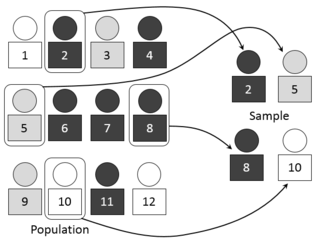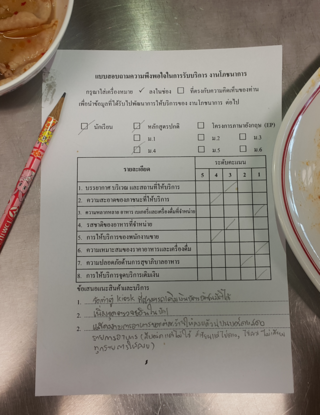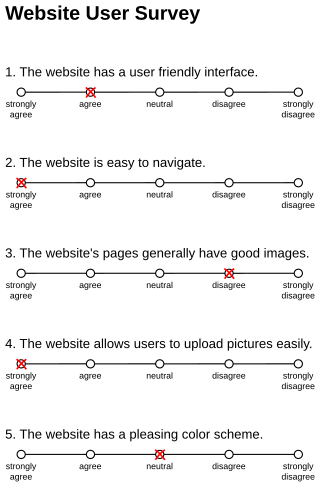Observational error is the difference between a measured value of a quantity and its true value. In statistics, an error is not necessarily a "mistake". Variability is an inherent part of the results of measurements and of the measurement process.
In statistics, survey sampling describes the process of selecting a sample of elements from a target population to conduct a survey. The term "survey" may refer to many different types or techniques of observation. In survey sampling it most often involves a questionnaire used to measure the characteristics and/or attitudes of people. Different ways of contacting members of a sample once they have been selected is the subject of survey data collection. The purpose of sampling is to reduce the cost and/or the amount of work that it would take to survey the entire target population. A survey that measures the entire target population is called a census. A sample refers to a group or section of a population from which information is to be obtained

In statistics, quality assurance, and survey methodology, sampling is the selection of a subset or a statistical sample of individuals from within a statistical population to estimate characteristics of the whole population. Statisticians attempt to collect samples that are representative of the population. Sampling has lower costs and faster data collection compared to recording data from the entire population, and thus, it can provide insights in cases where it is infeasible to measure an entire population.
Questionnaire construction refers to the design of a questionnaire to gather statistically useful information about a given topic. When properly constructed and responsibly administered, questionnaires can provide valuable data about any given subject.
Survey methodology is "the study of survey methods". As a field of applied statistics concentrating on human-research surveys, survey methodology studies the sampling of individual units from a population and associated techniques of survey data collection, such as questionnaire construction and methods for improving the number and accuracy of responses to surveys. Survey methodology targets instruments or procedures that ask one or more questions that may or may not be answered.
Quantitative marketing research is the application of quantitative research techniques to the field of marketing research. It has roots in both the positivist view of the world, and the modern marketing viewpoint that marketing is an interactive process in which both the buyer and seller reach a satisfying agreement on the "four Ps" of marketing: Product, Price, Place (location) and Promotion.
An opinion poll, often simply referred to as a survey or a poll, is a human research survey of public opinion from a particular sample. Opinion polls are usually designed to represent the opinions of a population by conducting a series of questions and then extrapolating generalities in ratio or within confidence intervals. A person who conducts polls is referred to as a pollster.

A Likert scale is a psychometric scale named after its inventor, American social psychologist Rensis Likert, which is commonly used in research questionnaires. It is the most widely used approach to scaling responses in survey research, such that the term is often used interchangeably with rating scale, although there are other types of rating scales.

A questionnaire is a research instrument that consists of a set of questions for the purpose of gathering information from respondents through survey or statistical study. A research questionnaire is typically a mix of close-ended questions and open-ended questions. Open-ended, long-term questions offer the respondent the ability to elaborate on their thoughts. The Research questionnaire was developed by the Statistical Society of London in 1838.

Response bias is a general term for a wide range of tendencies for participants to respond inaccurately or falsely to questions. These biases are prevalent in research involving participant self-report, such as structured interviews or surveys. Response biases can have a large impact on the validity of questionnaires or surveys.
Computer-assisted personal interviewing (CAPI) is an interviewing technique in which the respondent or interviewer uses an electronic device to answer the questions. It is similar to computer-assisted telephone interviewing, except that the interview takes place in person instead of over the telephone. This method is usually preferred over a telephone interview when the questionnaire is long and complex. It has been classified as a personal interviewing technique because an interviewer is usually present to serve as a host and to guide the respondent. If no interviewer is present, the term Computer-Assisted Self Interviewing (CASI) may be used. An example of a situation in which CAPI is used as the method of data collection is the British Crime Survey.
In social science research, social-desirability bias is a type of response bias that is the tendency of survey respondents to answer questions in a manner that will be viewed favorably by others. It can take the form of over-reporting "good behavior" or under-reporting "bad", or undesirable behavior. The tendency poses a serious problem with conducting research with self-reports. This bias interferes with the interpretation of average tendencies as well as individual differences.
A self-report study is a type of survey, questionnaire, or poll in which respondents read the question and select a response by themselves without any outside interference. A self-report is any method which involves asking a participant about their feelings, attitudes, beliefs and so on. Examples of self-reports are questionnaires and interviews; self-reports are often used as a way of gaining participants' responses in observational studies and experiments.
Acquiescence bias, also known as agreement bias, is a category of response bias common to survey research in which respondents have a tendency to select a positive response option or indicate a positive connotation disproportionately more frequently. Respondents do so without considering the content of the question or their 'true' preference. Acquiescence is sometimes referred to as "yea-saying" and is the tendency of a respondent to agree with a statement when in doubt. Questions affected by acquiescence bias take the following format: a stimulus in the form of a statement is presented, followed by 'agree/disagree,' 'yes/no' or 'true/false' response options. For example, a respondent might be presented with the statement "gardening makes me feel happy," and would then be expected to select either 'agree' or 'disagree.' Such question formats are favoured by both survey designers and respondents because they are straightforward to produce and respond to. The bias is particularly prevalent in the case of surveys or questionnaires that employ truisms as the stimuli, such as: "It is better to give than to receive" or "Never a lender nor a borrower be". Acquiescence bias can introduce systematic errors that affect the validity of research by confounding attitudes and behaviours with the general tendency to agree, which can result in misguided inference. Research suggests that the proportion of respondents who carry out this behaviour is between 10% and 20%.
Participation bias or non-response bias is a phenomenon in which the results of elections, studies, polls, etc. become non-representative because the participants disproportionately possess certain traits which affect the outcome. These traits mean the sample is systematically different from the target population, potentially resulting in biased estimates.
In statistics, non-sampling error is a catch-all term for the deviations of estimates from their true values that are not a function of the sample chosen, including various systematic errors and random errors that are not due to sampling. Non-sampling errors are much harder to quantify than sampling errors.
Mode effect is a broad term referring to a phenomenon where a particular survey administration mode causes different data to be collected. For example, when asking a question using two different modes, responses to one mode may be significantly and substantially different from responses given in the other mode. Mode effects are a methodological artifact, limiting the ability to compare results from different modes of collection.
In survey sampling, Total Survey Error includes all forms of survey error including sampling variability, interviewer effects, frame errors, response bias, and non-response bias. Total Survey Error is discussed in detail in many sources including Salant and Dillman.
With the application of probability sampling in the 1930s, surveys became a standard tool for empirical research in social sciences, marketing, and official statistics. The methods involved in survey data collection are any of a number of ways in which data can be collected for a statistical survey. These are methods that are used to collect information from a sample of individuals in a systematic way. First there was the change from traditional paper-and-pencil interviewing (PAPI) to computer-assisted interviewing (CAI). Now, face-to-face surveys (CAPI), telephone surveys (CATI), and mail surveys are increasingly replaced by web surveys.
The interviewer effect is the distortion of response to a personal or telephone interview which results from differential reactions to the social style and personality of interviewers or to their presentation of particular questions. The use of fixed-wording questions is one method of reducing interviewer bias. Anthropological research and case-studies are also affected by the problem, which is exacerbated by the self-fulfilling prophecy, when the researcher is also the interviewer it is also any effect on data gathered from interviewing people that is caused by the behavior or characteristics of the interviewer.



